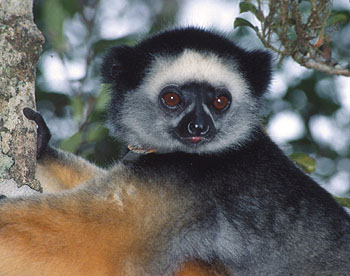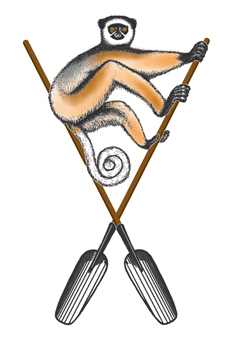SADABE is a non-governmental organization (NGO) formed by scientists working in Tsinjoarivo, Madagascar, who wanted to help the local people who had hosted and facilitated their research.
“Sada” means multicoloured in the Malagasy language, and “-be” means big. Sadabe (pronounced sah-dah-BAY) is the local name for the diademed sifaka (Propithecus diadema) – the largest of ten lemur species found at Tsinjoarivo. Its coat colour is a stunning combination of white, black and orange – a unique combination among primates.
 |
The Sadabe was the first lemur species studied intensively at Tsinjoarivo, by Dr. Mitch Irwin, Dr. Karen Samonds and Jean-Luc Raharison. Since their research began in 2000 they were struck by the pressing needs of the local human population. Remote, rural, and largely untouched by government and international assistance, Tsinjoarivo residents live simple lives based on agriculture and natural resource extraction. Yet as the population expands, their demands on the environment increase. The forest recedes, with no formal forethought about the future of the landscape, due to individual year-to-year decisions. Without technical assistance, the people of Tsinjoarivo run the risk of exhausting the very forest that regulates water flow, cleans the air and provides natural raw materials. |
Irwin, Samonds and Raharison decided they could not do research in isolation. Starting in 2001, they began combining their research trips with education sessions, programs to improve the quality of education, and reforestation to regenerate natural forests. In 2007 they decided to form an official non-governmental organization: SADABE. Like the lemur they had studied for 7 years, they wanted to create an organization that had many colours, and was big. In other words, they wanted to promote several unique but synergistic activities (research, education, conservation, and development) within an organization that would eventually grow and have a significant impact on the future of both ecosystem health and human health and well-being at Tsinjoarivo.
The organization of SADABE is an outgrowth of the way our research has worked at Tsinjoarivo. The two Canadians would have certainly failed in their research without drawing on the strengths of Malagasy colleagues. And while the Malagasy could have gone it alone, we believe they benefit from a global perspective. Throughout our research we have solved problems by consensus, with strong voices from Malagasy scientists, government officials, our employees, and community members at many levels. Thus, we are proud to have substantial Malagasy representation on our Board of Directors, and we are also proud to have strong and lasting relationships with local communities at Tsinjoarivo. We constructed our logo to reflect this philosophy: the two shovels represent the hard work of the Malagasy and foreign stakeholders at Tsinjoarivo, and the lemur represents the biodiversity and ecosystem health that can be supported when such collaboration is possible. |
 |
Sadabe became a non-governmental organization (NGO) registered with the government of Madagascar in June 2009.

